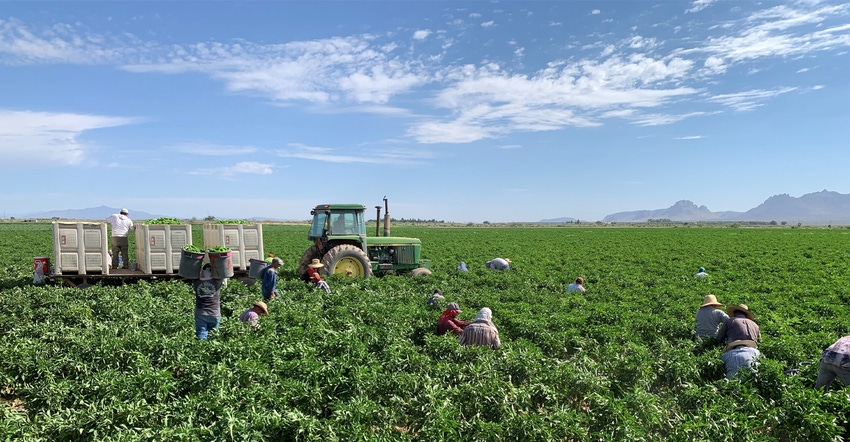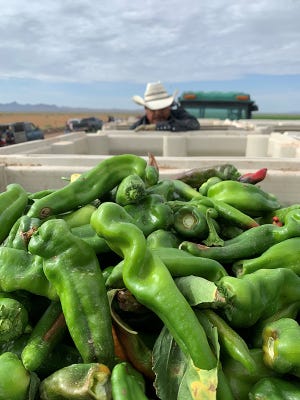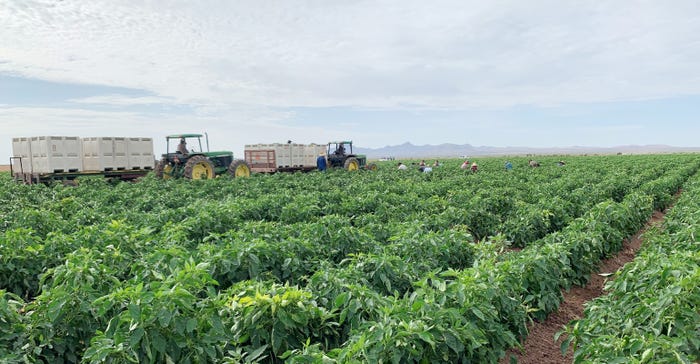
New Mexico chile farmers go into the 2021 seeding and transplanting season hoping for spring rain to break a drought. They also face labor issues, ongoing concerns from COVID-19, and competition from Mexico.
“The market has stabilized a little bit,” says Joram Robbs, executive director, New Mexico Chile Association, Deming, N.M.

Green chiles remain a viable product for New Mexico farmers. (Photo by Joram Robbs.)
In 1992, New Mexico farmers harvested 34,000 acres of chile peppers annually. By 2014 that number had declined to 8,000 to 9,000. “It’s stabilized now,” Robbs says. “We would like to see acreage increase but, at least for now, it is stable.”
The decline stems from competition just across the border where Mexico producers have increased acreage from about 5,000 to more than 80,000.
“Our challenge,” Robbs says, “is that Mexico can grow and sell chile cheaper than we can. Most of the red chile has gone to Mexico.”
Processing red chile, he adds, is not as time sensitive as it is for green chile, which must be moved quickly or it will spoil. “The green chile market saves us.”
Legislation to protect New Mexico chile also helps. The Chile Advertising Act makes it illegal to advertise chile as a “New Mexico” or “Hatch” if it is not grown in New Mexico. This legislation protects Hatch chile, requiring any chile designated as Hatch chile must be grown in the Hatch Valley of New Mexico.
Needing a rain
This legislation helps, Robbs says, but New Mexico chile producers still must produce good yields of high-quality peppers. That may be difficult without spring rain.
See photo gallery, New Mexico's green chile production
“Recent precipitation is barely helping,” he says. “We are in a horrible drought. Last year was bad; this year will be worse if we don’t get rain.”
He says the Colorado snowpack, a significant source of New Mexico’s water, has been light. “The state engineer has suggested water allotments will be cut if we don’t get a lot of spring rain.”
Direct seed planting has begun, Robbs says, and will continue until the first of April. “Transplanting will begin in mid-April and continue until the first of May. Some producers use transplants to shorten the irrigation season and save water.”
COVID repercussions
He says COVID-19 hurt the New Mexico chile industry last year and could have a lingering effect in 2021. He explains that much of the state’s green chile goes to restaurants. When COVID shut down restaurants last spring, the chile market suffered. Processors had nowhere to send chile products. Some of that backlog may remain and could affect 2021 markets, he says.
“Also, COVID affected harvest last year. Workers did not want to be close to other people, so a lot of chile was not harvested and left to rot in the fields. That situation could play out again this year.”
Robbs says the 2020 crop was a good one with yields up about 2,000 pounds per acre over 2019. Harvest season was near ideal, warm and dry, but without labor to harvest, some of it was lost.
Labor challenge
Labor is an ongoing challenge for New Mexico’s chile industry, and an issue Robbs would like to see Congress address in the next farm bill. “The H-2A program is great,” he says, “and it works well for larger farmers. Smaller farms, 200 to 300 acres, however, can’t afford it, with housing and other requirements.”
He says immigration reform, with a guest worker option similar to the old “Green Card” program for agricultural workers, would benefit New Mexico chile producers.

He also makes a case for crop subsidies. With the increase in minimum wage — set to move to $12 in 2023 in the state — New Mexico farmers can’t compete with Mexico, where regulations are much less restrictive and labor is much cheaper, he says. “Everything we grow is more expensive to produce but the price is about the same as it was years ago. We don’t want to raise the price of food.”
Mechanization option
Mechanization, Robbs says, may help reduce production costs. “Hopefully, mechanical harvest might be possible in the next five years,” he says.
That’s already an option for red chile but de-stemming and harvesting green chile is not yet feasible. Research on mechanization is ongoing.
Mechanization comes with a cost, however. “The chile industry accounts for 5,000 jobs in the state. Some growers like to employ hand labor. Many have worked with the same families for years and they like to have them back every year.”
It’s one of many challenges facing New Mexico’s chile industry as producers get the 2021 crop in the ground, hoping for rain, good markets, and adequate labor to pick the peppers the state is known for.
About the Author(s)
You May Also Like






